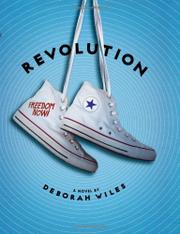We had a small group at our last meeting, and we unanimously loved Revolution by Deborah Wiles. We felt that the writing was exemplary, especially the beautiful phraseology she used without in any way ruining the voice of Sunny, the main character. We liked how the story was told from two points of view as Sunny, white, and Raymond, black, described the events that happened in their own lives in Greenwood, MS during Freedom Summer in 1964 when large numbers of young organized workers, black and white, came to the south from all over the United States to register black voters and to organize freedom schools. Interwoven with this important story was Sunny's wish to find her long, lost mother, and her interactions with various members of her family, including a new stepmother. We thought the plotting was excellent, and that the many pages of primary source materials, including song lyrics, pamphlets, photos, and other ephemera were especially helpful in understanding the era. We liked the inclusion of short accounts of the contributions of Pres. Lyndon B. Johnson's accomplishments, the story of the friendship between Polly Spiegel and Dorothy Height, and a discussion of the Viet Nam War. We were not sure if average young readers would automatically pick up this 544-page book, but we felt that with good book-talking by a teacher or a librarian they might try it, and that once they were 'into' the story they would stick with it.
We had varying opinions on Separate is Never Equal by Duncan Tonatiuh. We all thought this story of the original school desegregation case in Orange County, CA in 1947 which was a precursor to Brown v. Board of Education in 1954, was an important one that everyone should know. We agreed that the writing in this book was somewhat flat, although factual, as Sylvia Mendez's parents went to court so that Sylvia and her siblings could attend the 'white school,' which was in every way superior to the 'Mexican school' that they were forced to attend . . . not only visually, but also in terms of the education provided for the students. We were split in our opinions about the illustrations, even though they had won the Pura Belpre Award for illustration. Though he used art reminiscent of Mixtec codexes from Mexico, some of our members thought the illustrations were also flat and quite unexpressive, while others of us felt that they were excellent examples of Mexican culture and fit the story well. We felt that the book was certainly very accessible to young readers, and that they would learn a lot from reading it and possibly want to do more research on this issue.
WELCOME
WELCOME! For the last 19 years, about once a month, usually on a Thursday evening, a group of writers, illustrators, teachers and librarians meets in the Los Feliz area of Los Angeles to discuss children's books. Lately we have started meeting at lunch time, once every three months. Usually we talk about one picture book and one middle grade or YA novel. After the meeting, Sandy Schuckett, a retired LAUSD librarian, summarizes our discussion. Here are her reports of our thoughts about the books we have read. We'd love to have your comments too!
Thanks to Nancy Hayashi for our wonderful title art! NOTE: We are changing to a new schedule. Our meetings will now be quarterly and during the afternoon. Our group has been meeting since 2007. It was organized under the auspices of the Children's Literature Council of Southern California (CLCSC).
Thanks to Nancy Hayashi for our wonderful title art! NOTE: We are changing to a new schedule. Our meetings will now be quarterly and during the afternoon. Our group has been meeting since 2007. It was organized under the auspices of the Children's Literature Council of Southern California (CLCSC).
Thursday, October 29, 2015
Subscribe to:
Comments (Atom)

